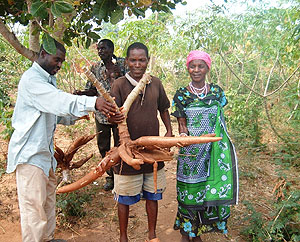RWANDA is banking on cassava as a potential solution to the limited supply of animal feeds, cited as one of the major challenges facing livestock farmers in the country.


RWANDA is banking on cassava as a potential solution to the limited supply of animal feeds, cited as one of the major challenges facing livestock farmers in the country.Dafrose Gahakwa, the Deputy Director General of Research at Rwanda Agricultural Board (RAB) told Business Times that government was putting efforts to boost production of the crop as part of a plan to increase food security in the country. "Cassava leaves are rich in protein because they contain 24 percent of protein that can be used as animal feeds,” said Gahakwa. According to Food and Agricultural Organisation (FAO), cassava leaves and roots contain major ingredients that can make feeds for pigs, cows and poultry. While global demand for animal feed is growing at two percent a year due to the rapidly growing livestock population, productivity levels are low because of lack of quality concentrated feeds, according to FAO. Back home, output for animal feeds is projected to reach 12,000 metric tonnes per year in the next four years with a potential export market of 3,500 tonnes to the Democratic Republic of Congo and Burundi.Sam Rubagunya, the Managing Director of SOPAR—a local animal feeds manufacturer said that commercial farmers currently mix the feeds themselves on site while others own small machines.SOPAR is among eight local firms said to be financially struggling and desperately in need of state bailout. The company needs a working capital of around US$1.5 to enable it to resume operations. "The machines are idle, but we recently had a meeting with (the) Ministry of Agriculture and the Ministry of Trade and Industry. We hope to get a strategic partner or government bailout,” Rubagumya noted.Cassava is a staple food for most Rwandans and has different varieties. It is also drought-resistant in comparison to other crops.According to Gahakwa, to date, 20,000 tonnes of cassava leaves, and 40,000 roots are harvested per hectare daily. She disclosed that government intends to sensitise farmers to plant the crop as it can be grown in many parts of the country."We need to scale up the production of this crop because our country is hilly and cassava can grow well on hilly terrain,” she assured.Recent Food and Agriculture Organisation research findings indicate that the market for cassava as a foodstuff provides the greatest potential for the greatest number of countries.Recently, Government launched a Rwf6 billion cassava processing factory in the Southern Province to process 144 tonnes of cassava with an output of 45 tonnes of flour per day. Other than flour production, waste from cassava processing will be treated and converted into fertiliser and animal feeds.Cassava is mainly grown in Southern Province but government intends to expand its acreage to 90,000 hectares from 70,000 hectares.


